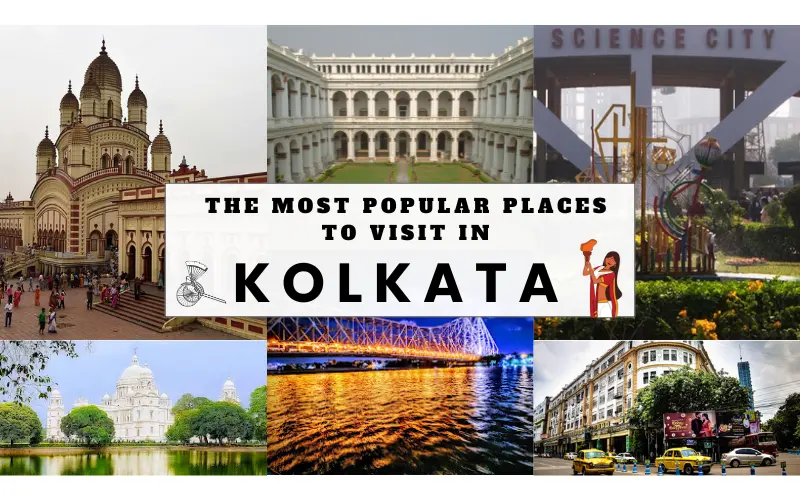Ganesh Chaturthi is a festival that is celebrated for 11 days with amazing ambience, drumbeats, and the chants of Lord Ganapati everywhere. Many groups in India are known for making the best pandals and idols of Lord Ganesha for many years. In this article, we list the top famous places to visit during Ganesh Chaturthi in India.
1. Khairtabad, Hyderabad
Khairtabad Ganesh is one of the world’s largest Ganesh idols installed during the festival. In 1954, a 1-foot-high idol of the Ganesha was established at the locality. It was started by Singari Shankaraiah who was inspired by Bal Gangadhar Tilak’s call to celebrate the festival as a mark of unity. Since that year, the height of the idol increased by one foot every year. Thousands of devotees from across the state visit this magnificent idol every year. In 2022, the committee has announced their 70-foot eco-friendly Ganesh idol made out of clay which will be immersed at the site itself.

2. Lalbaugcha Raja, Mumbai
Lalbaugcha Raja is one of the most visited Ganesh idols in Mumbai. The idol of Lalbaugcha Raja is designed wonderfully and it is patent protected. People believe that Lalbaugcha Raja will fulfil their wishes that is why it takes almost 20 hours to get a glimpse of this beautiful idol. Many popular celebrities and politicians visit this pandal every year. The Mandal was founded in the year 1934 and has grown gradually.

3. Balapur Ganesha, Rangareddy
Balapur Ganesha is known for its Laddu auction. The auctioning was first held in 1994 when the laddu was brought for Rs 450, and since then the laddu auction rates have been increasing every year. Bidders from Telangana and Andhra Pradesh participate in the bidding, as it is believed that the laddu brings luck and prosperity. In 2021, the Balapur laddu was auctioned for a whopping rate of Rs 18.90 lakhs.

4. GSB Seva Mandal Ganapati, Mumbai
GSB Seva Mandal Ganapati is considered one of the richest mandals (administrative divisions) in Mumbai. Every year the Ganesh idol is adorned with gold and silver ornaments. Thousands of devotees from across the state visit it every year to seek the blessings of the lord. This is the only pandal in Mumbai where the rituals are performed round the clock.

5.Ganesh Galli Mumbaicha Raja, Mumbai
Ganesh Galli is located only a couple of lanes away from the Lalbaugha Raja. The Mandal was formed for the benefit of the mill workers in the year 1928 making it one of the oldest and most popular pandals in India. The pandal is known for the novel new themes every year and they often replicate famous places of India.

6.Andhericha Raja, Mumbai
Andhericha Raja was founded in 1966 by Tata Special Steel and Excel Industries Limited. Every year, a huge crowd of devotees, Bollywood celebrities, and politicians come here for darshan. The immersion process is routed throughout the entire Andheri village, and it begins at 5 in the evening and reaches the seashore the next day morning.

7. Tulshi Baug Ganpati, Pune
Tulshi Baug Ganpati is the largest Ganesh idol in Pune. Established in 1901, the idol stands at a height of 15 feet and the Mandal brings new themes every year. The idol does not move to another location and the lord is worshipped throughout the year. It is believed that the shopkeepers of Tulshi Baug businesses flourish because of the blessings of the Lord Ganesha.

8. Kanipakam, Andhra Pradesh
Kanipakam village is in Andhra Pradesh. It is believed that the Vinayaka idol here is said to be growing in size over time. Chola king, Kulothunga Chola built the temple in the 11th century. The annual festival is held for 21 days, beginning on the day of Vinayaka Chavithi. The festival idol is taken out in procession on all days, and it is colourfully decked.

9.Panchamuki Heramba Ganesha Temple, Bengaluru
Panchamukhi Heramba Ganesha Temple in Bengaluru is one of the popular places where Vinayaka Chaturthi is celebrated with great fanfare in the city. Here the lord is seen as Pancha Mukha which means five faces along with five bodies. Every year special pujas are conducted during the festival times and thousands of devotees from the state and the neighbouring states visit this amazing temple.

10. Khetwadicha Ganraj, Mumbai
The Khetwadicha Ganraj is considered to be one of the most spectacular Ganesh idols in Mumbai. The Mandal was established in 1959 and the year 2000, the idol was decked with real gold jewellery and diamonds. The best time to visit Khetwadi Ganraj is during the daytime because the peak time starts in the evening and there are different Ganesh idols in every lane, so it would take some time to visit all the pandals around the area.

11. Fort Vibhag Sarvajanik Ganeshotsav Mandal Circle, Mumbai
Fort Vibhag Sarvajanik Pandal is full of colours, captivating lord Ganesha with grand royal decorations. The interiors are grand and majestic with artisans from Rajasthan who design this pandal. In 2012, the Mandal made a replica of the Lakshmi Villas palace of Bikaner, Rajasthan. The Ganesh idol is adorned with gold ornaments and a silver crown.

Conclusion
These are the popular Ganesh pandals in India. Every year the festival is celebrated grandly in these places. From this year, the ban on poP idols has been implemented and the height of community idols should be as low as possible. We must bring awareness amongst the people to celebrate the festival in an eco-friendly manner and protect our environment.





























